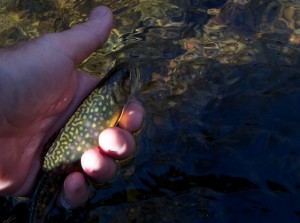
From a piece by Nick Lyons, “Following a Fluid Trail Even Higher,” originally published in the New York Times “Outdoors” column on February 22, 1996 and reprinted in the excellent book of essays, Upriver and Downstream. His curiosity compelled him to trace the trails of rivers and reservoirs feeding New York City, further and further upstream, into the Catskills and to the headwaters streams that hold what are, in too many places, the last of our native brook trout:
These are wild brook trout — five, six, sometimes eight inches, on rare occasions a foot long. They have flanks as smooth as an otter’s skin, a dark mottled back, rose marks the color of wild strawberries, and striped fins. They wiggle like live jewels when you hoist them out of the water.
Greedy and wanton to their near extinction, vulnerable, full of a wildness that cannot protect itself, these fish are the ultimate symbol of piscatorial wildness, and it delights me to catch a dozen on barbless hooks and slip them swiftly back into their element. When I first climbed to the fountainhead of all city water and saw them, I stopped thinking of exotic Canadian fish and knew I had found a quiet place that satisfied all my longings.
Little do these diminutive flashes of light and color know the fate, downriver, of the precious, pure liquid in which they flourish. Little do they care — so long as it is there, so long as the great cities do not drink them into extinction. They are beautiful, rare creatures that dance in my head and I think of them even now, in the dead of winter, every time I turn on and turn off the faucet.
For people who cannot comprehend why anyone goes to the lengths they go in order to catch these little fish, this passage may help reveal what captures the imaginations of those of us who do this. Or maybe not, in which case a lot of hope for humanity is simply gone.
